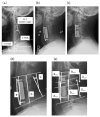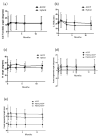Anterior Cervical Corpectomy with Fusion versus Anterior Hybrid Fusion Surgery for Patients with Severe Ossification of the Posterior Longitudinal Ligament Involving Three or More Levels: A Retrospective Comparative Study
- PMID: 34830602
- PMCID: PMC8624558
- DOI: 10.3390/jcm10225315
Anterior Cervical Corpectomy with Fusion versus Anterior Hybrid Fusion Surgery for Patients with Severe Ossification of the Posterior Longitudinal Ligament Involving Three or More Levels: A Retrospective Comparative Study
Abstract
Various studies have found a high incidence of early graft dislodgement after multilevel corpectomy. Although a hybrid fusion technique was developed to resolve implant failure, the hybrid and conventional techniques have not been clearly compared in terms of perioperative complications in patients with severe ossification of the posterior longitudinal ligament (OPLL) involving three or more levels. The purpose of this study was to compare clinical and radiologic outcomes between anterior cervical corpectomy with fusion (ACCF) and anterior hybrid fusion for the treatment of multilevel cervical OPLL. We therefore retrospectively reviewed the clinical and radiologic data of 53 consecutive patients who underwent anterior fusion to treat cervical OPLL: 30 underwent ACCF and 23 underwent anterior hybrid fusion. All patients completed 2 years of follow-ups. Implant migration was defined as subsidence > 3 mm. There were no significant differences in demographics or clinical characteristics between the ACCF and hybrid groups. Early implant failure occurred significantly more frequently in the ACCF group (5 cases, 16.7%) compared with the hybrid group (0 cases, 0%). The fusion rate was 80% in the ACCF group and 100% in the hybrid group. Although both procedures can achieve satisfactory neurologic outcomes for multilevel OPLL patients, hybrid fusion likely provides better biomechanical stability than the conventional ACCF technique.
Keywords: anterior cervical corpectomy and fusion; complications; fusion rate; graft subsidence; hybrid fusion; implant failure; mechanical stability; ossification of the posterior longitudinal ligament; perioperative outcomes; segmental paralysis.
Conflict of interest statement
The authors declare no conflict of interest. The sponsors had no role in the design, execution, interpretation, or writing of the study.
Figures



Similar articles
-
Hybrid Corpectomy and Disc Arthroplasty for Cervical Spondylotic Myelopathy Caused by Ossification of Posterior Longitudinal Ligament and Disc Herniation.World Neurosurg. 2016 Nov;95:22-30. doi: 10.1016/j.wneu.2016.07.065. Epub 2016 Jul 26. World Neurosurg. 2016. PMID: 27474455
-
Increased Height of Fused Segments Contributes to Early-Phase Strut Subsidence after Anterior Cervical Corpectomy with Fusion for Multilevel Ossification of the Posterior Longitudinal Ligament.Spine Surg Relat Res. 2020 Mar 19;4(4):294-299. doi: 10.22603/ssrr.2019-0102. eCollection 2020. Spine Surg Relat Res. 2020. PMID: 33195852 Free PMC article.
-
Anterior cervical corpectomy and fusion versus posterior laminoplasty for the treatment of oppressive myelopathy owing to cervical ossification of posterior longitudinal ligament: a meta-analysis.Eur Spine J. 2018 Jun;27(6):1375-1387. doi: 10.1007/s00586-017-5451-6. Epub 2018 Jan 15. Eur Spine J. 2018. PMID: 29335903
-
Anterior corpectomy comparing to posterior decompression surgery for the treatment of multi-level ossification of posterior longitudinal ligament: A meta-analysis.Int J Surg. 2017 Apr;40:91-96. doi: 10.1016/j.ijsu.2017.02.058. Epub 2017 Feb 22. Int J Surg. 2017. PMID: 28254423 Review.
-
Hybrid Decompression Technique Versus Anterior Cervical Corpectomy and Fusion for Treating Multilevel Cervical Spondylotic Myelopathy: Which One Is Better?World Neurosurg. 2015 Dec;84(6):2022-9. doi: 10.1016/j.wneu.2015.08.039. Epub 2015 Sep 2. World Neurosurg. 2015. PMID: 26342779 Review.
Cited by
-
Posterior hybrid surgery for atlantoaxial dislocation coexisting with multilevel cervical spondylotic myelopathy.Front Surg. 2023 Jun 2;10:1164298. doi: 10.3389/fsurg.2023.1164298. eCollection 2023. Front Surg. 2023. PMID: 37334204 Free PMC article.
-
[Study on application of ultrasonic bone curette in anterior cervical spine surgery].Zhongguo Xiu Fu Chong Jian Wai Ke Za Zhi. 2023 Aug 15;37(8):996-1001. doi: 10.7507/1002-1892.202302024. Zhongguo Xiu Fu Chong Jian Wai Ke Za Zhi. 2023. PMID: 37586801 Free PMC article. Chinese.
-
Prospective Comparative Study of Dysphagia after Subaxial Cervical Spine Surgery: Cervical Spondylotic Myelopathy and Posterior Longitudinal Ligament Ossification.J Clin Med. 2023 Feb 23;12(5):1774. doi: 10.3390/jcm12051774. J Clin Med. 2023. PMID: 36902561 Free PMC article.
-
Anterior Decompression and Fusion for the Treatment of Cervical Myelopathy Caused by Ossification of the Posterior Longitudinal Ligament: A Narrative Review.Asian Spine J. 2023 Jun;17(3):582-594. doi: 10.31616/asj.2022.0003. Epub 2023 Jan 17. Asian Spine J. 2023. PMID: 36647198 Free PMC article.
-
Novel Technique of Anterior Foraminotomy Based on Augmented Reality with Computed Tomography Navigation System: A Case Report.Spine Surg Relat Res. 2023 Oct 13;8(1):114-117. doi: 10.22603/ssrr.2023-0162. eCollection 2024 Jan 27. Spine Surg Relat Res. 2023. PMID: 38343405 Free PMC article. No abstract available.
References
-
- Sasaki E., Ono A., Yokoyama T., Wada K., Tanaka T., Kumagai G., Iwasaki H., Takahashi I., Umeda T., Nakaji S., et al. Prevalence and symptom of ossification of posterior longitudinal ligaments in the Japanese general population. J. Orthop. Sci. 2014;19:405–411. doi: 10.1007/s00776-014-0552-0. - DOI - PubMed
-
- Iwasaki M., Okuda S., Miyauchi A., Sakaura H., Mukai Y., Yonenobu K., Yoshikawa H. Surgical strategy for cervical myelopathy due to ossification of the posterior longitudinal ligament: Part 1: Clinical results and limitations of laminoplasty. Spine (Phila Pa 1976) 2007;32:647–653. doi: 10.1097/01.brs.0000257560.91147.86. - DOI - PubMed
Grants and funding
LinkOut - more resources
Full Text Sources

